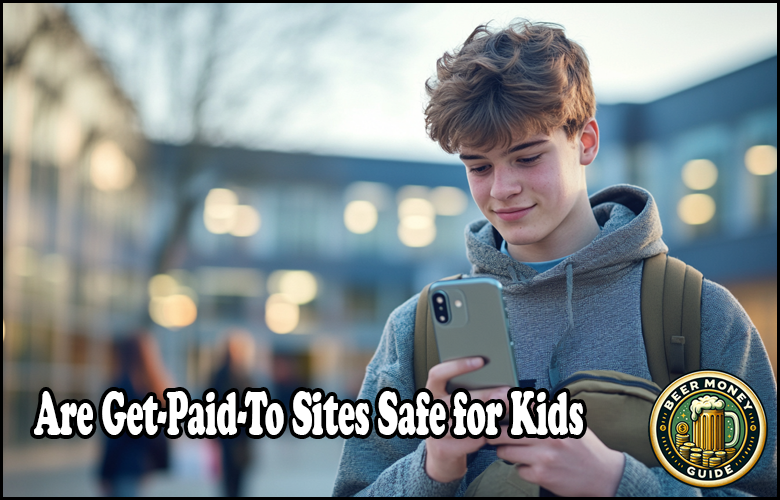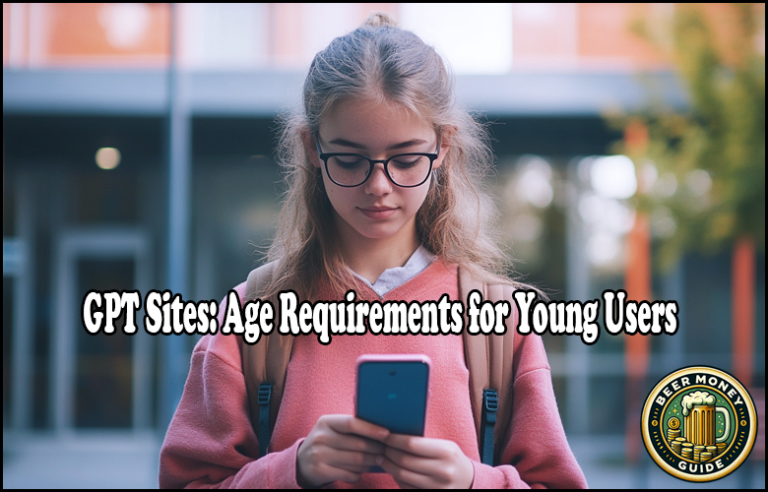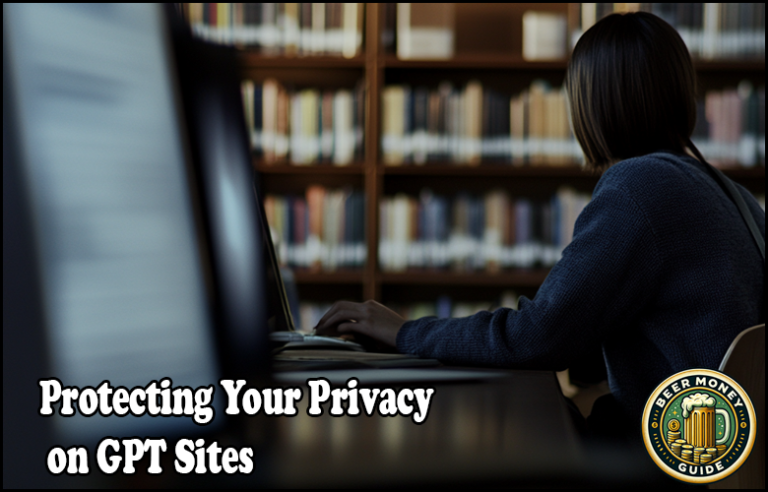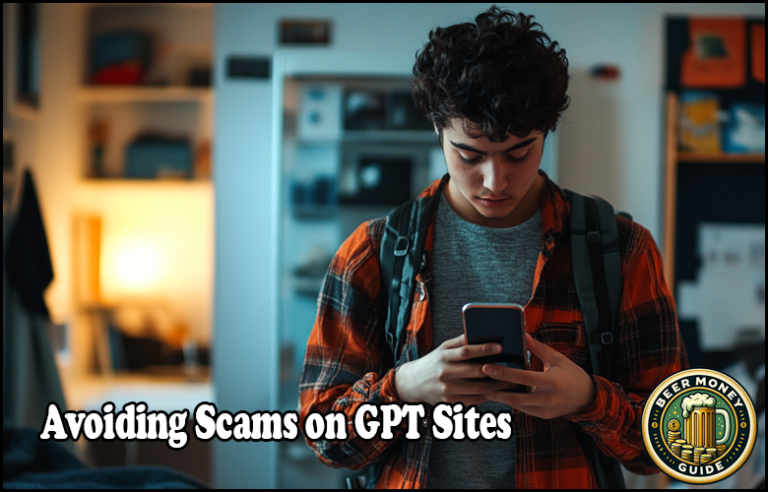“Get-paid-to” sites are becoming popular, especially with younger people.
Parents wonder if they should worry about these sites and their effects on their kids.
This article will look into Are Get Paid To Sites Safe for Kids?
We’ll talk about the good and bad sides.
We’ll also give tips on how parents can deal with these sites safely.
By understanding these platforms better, parents can make smart choices and keep their kids safe online.
Our Main Points
- Get-paid-to sites offer online earning opportunities for kids, but parents should be aware of potential risks.
- Developing children’s financial literacy is crucial to help them navigate the complexities of these platforms.
- Effective parental control and monitoring can mitigate risks and ensure a safe online experience for minors.
- Ethical considerations in youth entrepreneurship must be carefully evaluated.
- Safe and age-appropriate online earning opportunities can provide valuable learning experiences for kids.
Understanding Get-Paid-To Sites
In today’s digital world, online earning opportunities are getting more popular.
Get-paid-to sites are a big part of this trend. They let people earn money by doing tasks, taking surveys, or other activities. These sites can teach kids about money and responsibility.
Are Get Paid To Sites Safe for kids?
Get-paid-to sites are online places where users, including kids, can earn rewards like gift cards or cash. These rewards come from doing things like taking surveys, watching videos, or playing games.
While they can help kids make extra money, parents should know the good and bad sides of these sites.
Types of Get-Paid-To Sites for Kids
There are many kinds of get-paid-to sites for kids, each with its own special features.
Here are some examples:
- Survey sites: These give rewards for filling out online surveys. This helps companies understand what consumers want.
- Task-based sites: Kids can earn by doing easy tasks, like watching videos or playing games.
- Referral sites: These sites pay users for inviting friends and family to join and participate.
- Microtask platforms: These break big tasks into small ones. Kids can do these quickly for a little money.
Parents should look into these get-paid-to sites for their kids carefully.
They should make sure they’re safe, trustworthy, and right for their kids’ interests and age.
| Site Type | Example Activities | Potential Rewards |
|---|---|---|
| Survey Sites | Completing online surveys | Gift cards, cash |
| Task-based Sites | Watching videos, playing games, data entry | Gift cards, points, virtual currency |
| Referral Sites | Inviting friends to sign up | Bonuses, commissions |
| Microtask Platforms | Completing small, simple tasks | Cash, gift cards |
Knowing about the types of get-paid-to sites for kids helps parents decide if they’re good for their kids.
Potential Risks and Concerns
Get-paid-to sites can be a way for kids to make money, but they have risks too. These include privacy and security risks, and the chance of exploitation and scams.
Parents should check if a site is safe and real before letting their kids join.
Privacy and Security Risks
Many get-paid-to sites ask for personal info like names, addresses, and financial details. This info can be at risk of being shared without permission.
Parents should watch what info their kids share. They should also make sure the site protects their data well.
Exploitation and Scams
Some get-paid-to sites might be hiding harmful or fake plans. Kids could be tricked into doing things or sharing private info, risking their safety or money.
Parents should look into a site well before letting their kids join. They should be careful of sites that seem too good to be true.
Knowing the potential risks helps parents keep their kids safe on get-paid-to sites. This way, their online work can be both safe and rewarding.
Developing Financial Literacy in Kids
Get-paid-to sites are great for teaching children’s financial literacy. They help kids learn how to earn, manage, and save money. This knowledge is key for their future success.
Parents can use these sites to talk about budgeting, saving, and smart money choices.
It’s important to teach kids about handling money early on. Get-paid-to sites let kids earn money and learn important financial lessons. They can learn about:
- Budgeting and allocating funds
- Saving for short-term and long-term goals
- Differentiating between needs and wants
- Making informed spending decisions
Parents can guide their kids in managing their money. This helps build a strong financial foundation. Such skills are crucial for dealing with money in the future.
Do parents need to worry about get-paid-to sites for their kids? It’s not a simple answer. These sites can be great for teaching kids about money. But, parents must stay involved to keep their kids safe and financially smart.
Parental Control and Monitoring
Parents need to be careful when their kids use get-paid-to sites. It’s key to set clear rules and watch over their online actions. Using parental control tools can lower risks and make sure kids have a safe online experience.
Setting Ground Rules and Limits
Parents should work with their kids to make rules for get-paid-to sites. This includes:
- Setting time limits for how much they can use these platforms
- Blocking access to sites or content that’s not right for them
- Need for parent okay before doing any financial deals or signing up
- Talking openly and understanding online safety together
Monitoring Online Activities
It’s important to keep an eye on what kids do online at get-paid-to sites. Parents can:
- Look at their kids’ browsing history and activity logs to make sure they’re using it right
- Use tools or apps to watch and filter what they see online
- Ask their kids about their online experiences and any worries they have
- Keep up with the latest in get-paid-to to spot and fix problems early
By being active in monitoring online activities and setting ground rules and limits, parents can create a safe online space for their kids to try out get-paid-to sites.
Do Parents Need to Worry About Get-Paid-To Sites for Their Kids?
In today’s digital world, kids have more ways to earn money online, like get-paid-to sites. Parents might wonder if these sites are safe and beneficial for their kids. It’s important to look at the good and bad sides of these platforms.
Get-paid-to sites let kids do tasks like surveys, watch videos, or do simple online jobs for small rewards. They seem like a fun way for kids to make some extra cash. But, parents should worry about privacy and security risks and the chance of exploitation and scams on these sites.
To keep things safe, parents should teach their kids about money. Learning about budgeting, saving, and managing money wisely is key. This way, kids can make smart choices about joining get-paid-to sites. It helps reduce risks and lets kids enjoy the benefits of earning online.
Deciding if kids can use get-paid-to sites should be a careful choice for parents. By staying updated, setting rules, and teaching kids about money, parents can keep their kids safe online.
This helps kids learn and stay safe in the digital world.
Internet Safety for Minors
Parents today face many challenges in keeping their kids safe online. They must worry about get-paid-to sites and other internet safety issues. It’s important to know how to protect your children in the digital world.
Online Predators and Cyberbullying
Online predators and cyberbullying are big threats for kids online. Parents should teach their kids about these dangers and how to spot and report them. Using parental controls and watching what your kids do online can make it safer for them.
Digital Footprint and Reputation Management
What your kids do online can affect their future. Parents should teach them about the lasting effects of their online actions and the value of a good online image. Talking about how online actions can be permanent and sharing too much can hurt them can help kids act responsibly online.
By focusing on internet safety for minors, online predators, and managing their digital footprint, parents can help their kids stay safe and do well online.
| Online Safety Risks | Potential Consequences | Preventive Measures |
|---|---|---|
| Online Predators | Exploitation, Abuse | Education, Parental Monitoring |
| Cyberbullying | Emotional Distress, Mental Health Issues | Awareness, Reporting Systems |
| Digital Footprint | Reputation Damage, Future Opportunities | Digital Literacy, Responsible Sharing |
Ethical Considerations in Youth Entrepreneurship
Parents looking into get-paid-to sites for their kids should think about the ethical sides of youth entrepreneurship. These sites can help kids earn money and learn new skills. But, they also bring up worries about child labor laws and using minors for work.
The article talks about the ethical sides of youth entrepreneurship and get-paid-to sites. Parents and those making rules need to make sure these sites follow child labor laws and regulations. They should also make sure kids aren’t being used too much or unfairly.
There are many ethical considerations in youth entrepreneurship to think about. This includes how it affects a child’s school, work-life balance, and happiness.
Parents should also think about if get-paid-to sites fit with their values and goals for their kids.
| Ethical Considerations | Potential Concerns | Recommended Practices |
|---|---|---|
| Child Labor Laws and Regulations | Exploitation, Excessive Work Hours | Ensure Compliance, Prioritize Education |
| Work-Life Balance | Stress, Burnout, Neglect of Other Activities | Set Reasonable Time Limits, Encourage Breaks |
| Educational Impact | Distractions, Compromised Academic Performance | Monitor Academic Progress, Provide Support |
| Parental Oversight | Lack of Supervision, Inappropriate Content | Establish Clear Guidelines, Regularly Review Activities |
By looking at these ethical considerations in youth entrepreneurship, parents and those making rules can make sure get-paid-to sites and other chances for kids to work are good for them.
They help kids learn and grow while keeping their well-being safe.

Safe Online Earning Opportunities for Kids
Parents might worry about get-paid-to sites for their kids, but there are safe and real ways for kids to make money online. These options let kids earn money safely and avoid the risks of get-paid-to sites.
Tutoring is a great choice. Kids who are good in certain subjects can teach others online. Sites like Chegg Tutors and Varsity Tutors help connect tutors with students. This way, kids can make money and share what they know.
- For kids who like to write, take pictures, or make videos, content creation is a good path. They can sell their work on sites like Etsy, Redbubble, and Shutterstock. This lets young people turn their creativity into cash.
- Micro-jobs are another safe choice. Kids can do small tasks on websites like Fiverr and Upwork. They can offer services like graphic design or help with online tasks for a little money.
By looking into safe online earning opportunities for kids, parents can help their kids learn valuable skills. They can also teach them about money in a safe way. These alternative earning options for minors give kids a positive way to earn and grow.
Teaching Kids About Money Management
It’s key for parents to teach kids about money management, even if they use get-paid-to sites. They should learn about budgeting, saving, and investing. This helps them build a strong financial future.
Budgeting and Saving Strategies
Start by teaching your kids how to budget. Help them sort their spending into needs, wants, and savings. Encourage them to save a part of their earnings, from any source, to grow their savings.
Investing and Long-Term Planning
When kids get better with money, talk about investing and planning for the future. Explain how spreading out investments can help them grow their money over time. Show them different ways to invest, like savings accounts and stocks, and what risks and rewards come with each.
Teaching kids about managing money, budgeting, saving, and investing prepares them for smart financial choices. This can ease worries about get-paid-to sites and give them a solid grasp of personal finance.
| Budgeting and Saving Strategies | Investing and Long-Term Planning |
|---|---|
|
|
Striking a Balance: Guidance and Autonomy
When parents look into get-paid-to sites for their kids, finding the right balance is key. They need to guide their kids but also let them make some choices. It’s important for kids to learn about money and making decisions on their own.
Setting ground rules and limits is a good start. Parents and kids can work together to decide how much time to spend on these sites. They can also agree on what activities are okay and how to handle the money earned. This way, kids learn about being responsible with money and trust grows between them and their parents.
But, parents should also keep an eye on their kids’ online activities. They need to check the sites they visit, look at their earnings, and talk about any problems. This helps parents guide their kids safely while letting them become more independent and financially smart.
Finding the right mix of guidance and autonomy is key for kids to use get-paid-to sites safely and wisely. This helps kids try out earning opportunities and teaches them to make smart choices.
It prepares them for a future where they can handle money well.
As we wrap up our look at get-paid-to sites for kids, we see the pros and cons. These sites can teach kids about money and help them earn extra. But, parents need to watch out for the potential risks and concerns.
By knowing the different kinds of sites, setting rules, and talking openly, parents can keep their kids safe and smart online. This way, kids can earn money safely and learn important lessons.
So, do parents need to worry about get-paid-to sites for their kids? It’s a complex question. Parents should guide their kids but also let them make choices. This helps kids learn how to handle money wisely.
Teaching kids about budgeting, saving, and managing money is key. This helps them make smart choices now and later.
In short, the takeaways are clear. It’s important to know the good and bad of get-paid-to sites. Use controls, teach kids about money, and keep the internet safe for them.
By being proactive and informed, parents can help their kids use these sites wisely. With the right support, kids can learn valuable lessons for their financial future.


Ryan Conlon is the founder and owner of Beer Money Guide, a comprehensive resource dedicated to helping people discover the best ways to earn extra cash online.
With a passion for exploring the digital landscape and a knack for finding lucrative opportunities, Ryan has turned his experience into a trusted guide for anyone looking to boost their income through legitimate online platforms.
When he’s not hunting down the latest money-making apps, Ryan enjoys sharing tips and strategies to help others achieve their financial goals.
Subscribe to Our Newsletter
The information on this website is for general purposes only and is not a substitute for professional financial advice.
Always consult a financial professional before making decisions.






